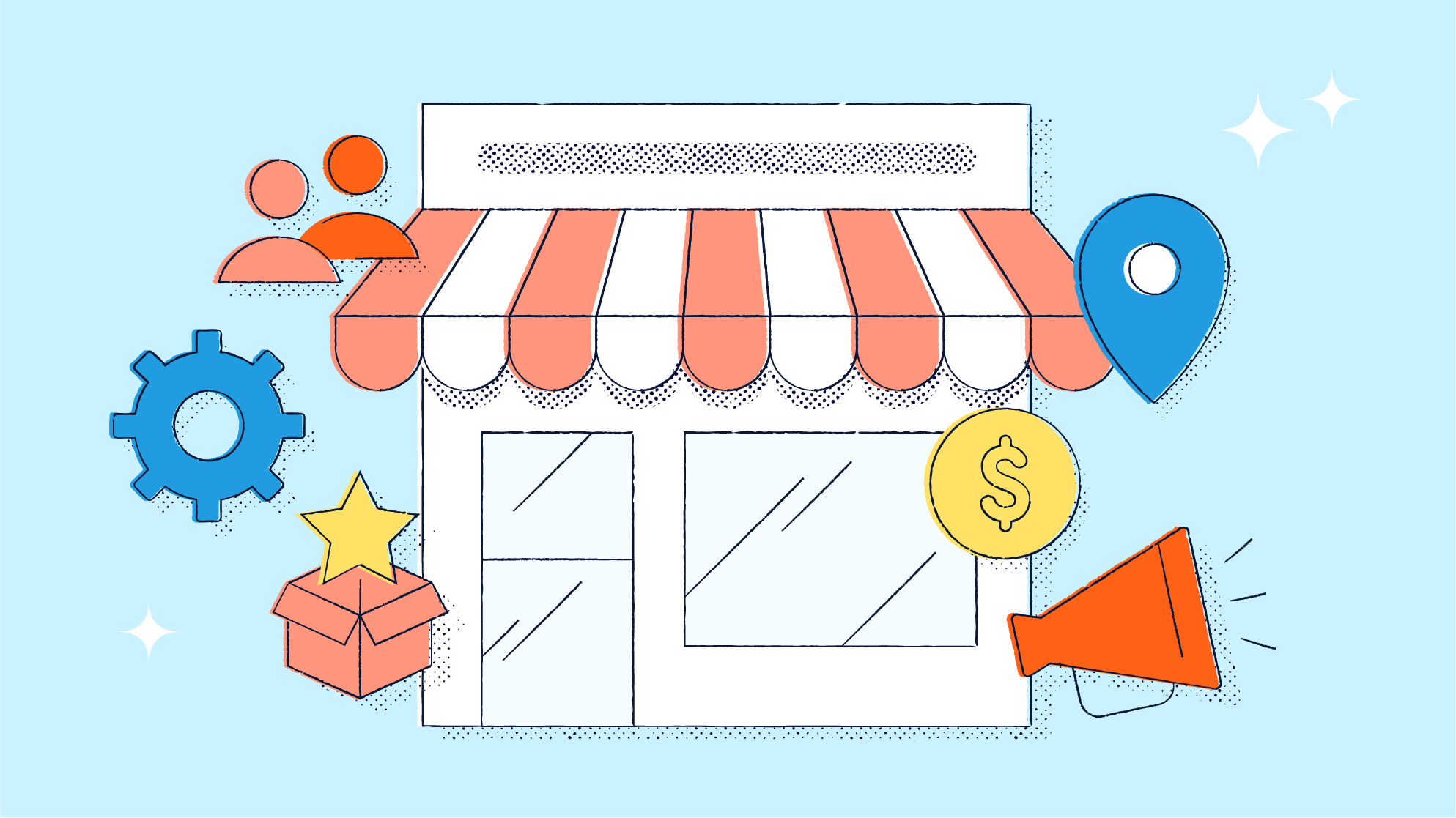
Getting your retail store to stand out from the competition is no small feat. It requires a robust marketing strategy that can adapt to technological shifts and changing consumer expectations. This article is packed with ideas and strategies to take your retail business to the next level.
What is retail marketing?
Retail marketing is the act of promoting products and services to generate sales. Retailers use a variety of strategies to create awareness, including advertising, promotions, branding, online marketing, pricing, customer service, merchandising, and more.
Types of marketing for retailers
Different types of retail marketing strategies yield different results. Retailers may use one or several different types of marketing depending on their goals. Here are some common ones that businesses typically make use of:
In-store marketing
In-store marketing, also known as brick-and-mortar marketing, includes in-store displays, promotions, product samples, events, and signage. In-store marketing is focused on offering the customer the best retail experience.
Online marketing
In this form of marketing, retailers use different online channels to promote sales, such as social media, emails, search engine optimization (SEO), and SMS messages.
Traditional marketing
Traditional marketing in retail refers to all offline-based channels for communicating with customers, including, but not limited to direct mail (such as brochures and postcards), print (like magazines and billboards), word-of-mouth, and phone calls.
Mobile marketing
This method targets customers via mobile devices such as smartphones or tablets. Examples of mobile marketing include text messages, push notifications, AR (augmented reality) activations, and QR Codes.
Learn to set up your own SMS marketing campaign.
The 6 P’s of retail marketing
Originally known as the marketing mix, the principles of marketing consisted of four essential ingredients. In today’s digital world, six principles make up the marketing mix. Together they complement each other and effectively contribute to a successful marketing strategy. These six principles are product, price, place, promotion, people, and presentation.
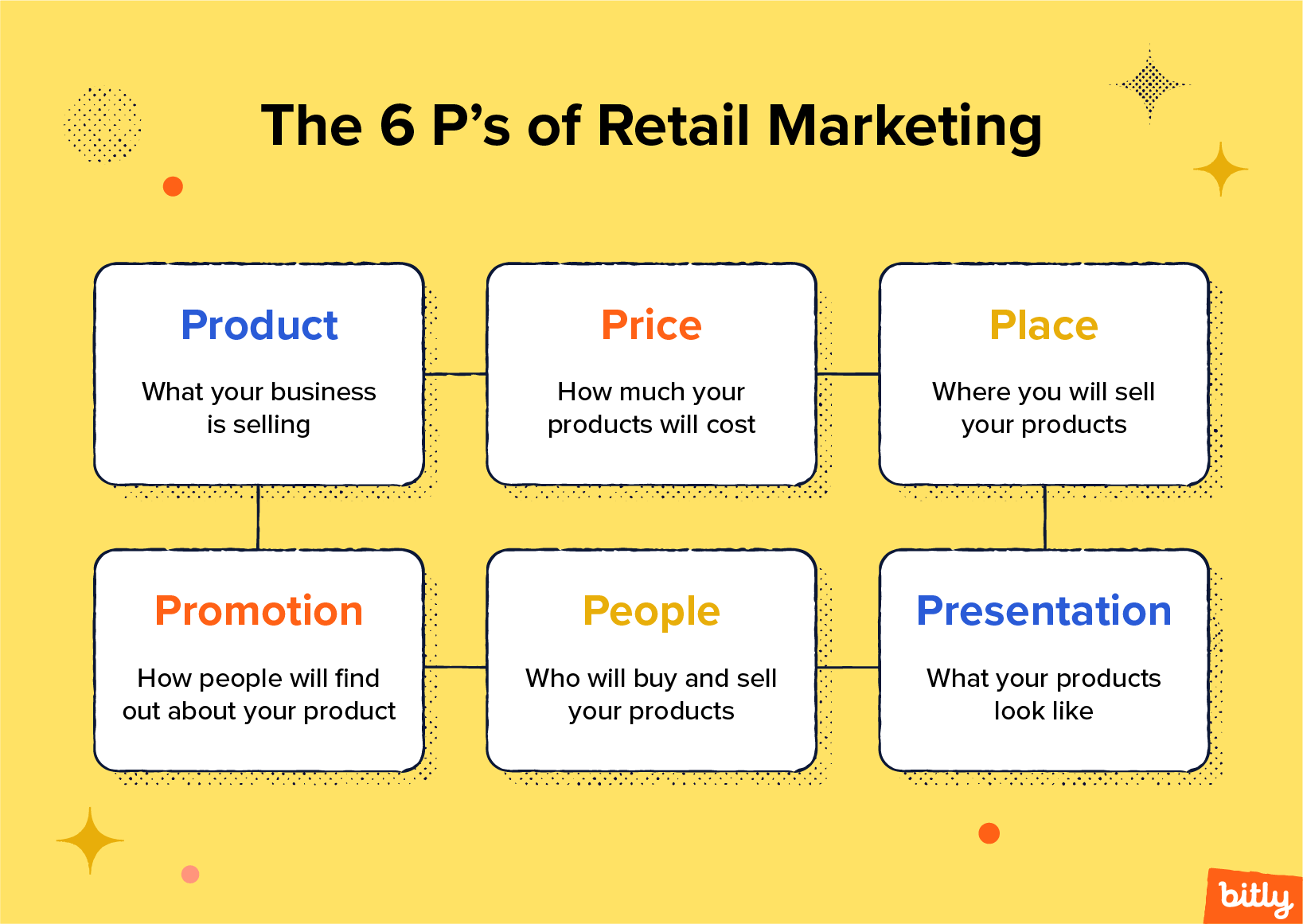
1. Product
In retail marketing, this would be the products or services a retailer offers in-store or online. It’s not enough to offer just any product, the product itself needs to have utility and fulfill the needs of a target audience to render it marketable.
2. Price
The price of your product is an important factor in your marketing strategy because it determines your business’s profit. Many factors contribute to pricing, from overhead expenses to production costs, and even what your competitors are offering. With the right pricing strategy, such as discounts, product bundles, or promotions, you can attract the right customers to your store.
3. Place
Two things need to be considered when thinking about the place: The location of your store in relation to your target customer and your distribution channels. Customers should be able to grab your products with minimal effort, so it’s key to make sure they’re within easy reach. A retailer’s role in channel distribution cannot be overstated—the journey between when consumers buy a product and when they receive it needs to be as short as possible and frictionless.
4. Promotion
The goal of this principle is to increase sales. To incite interest and boost awareness, retailers should employ different marketing strategies from traditional marketing to online marketing. A loyalty program is one of the most common retail marketing promotional strategies, in which the retailer offers discounts on specific products. Retail brands can gain a competitive edge and multiply conversion potential by combining these marketing efforts.
5. People
People are the backbone of your retail business. Your staff will be the ones on the front lines, so it’s important to hire people who are skilled at customer service and easy to talk to. It’s just as vital to provide comprehensive training programs to invest in your employees continually.
6. Presentation
Presentation refers to the appearance and the branding of your product. This will impact a customer’s purchase decision. The way you package your product, as well as how you display your product in your physical store, plays a pivotal role in how a product is perceived. Is the product display and packaging eye-catching? Is it desirable?
6 retail marketing strategies
We’ve pulled up six effective, cutting-edge retail strategies so you’ll have all the tools you need in your marketing toolkit. So whether you’re a newbie retail business owner, or a seasoned one looking to brush up on the most up-to-date strategies, you’ll find what you’re looking for below.
1. Develop partnerships
Collaborating with other companies and influencers can help you build brand credibility, which can have a powerful long-term effect. But if you’re hesitant to partner with an influencer, then perhaps you haven’t yet considered the growth aspect of influencer marketing, or that it has ballooned to a $16.4 billion industry as of 2022 according to findings by Influencer Marketing Hub.
Before reaching out to an influencer or partner, there are some best practices to take into account. You should aim to foster long-term relationships with influencers to avoid continual outsourcing. It’s also mutually beneficial to have a longstanding partnership, one you can actually count on and trust as an ally to your business.
Social media is a hub for influencers, with Instagram being one of the most popular platforms. Once you embark on a relationship with them, they can market your products through posts and stories, or even use a link-in-bio to link to your products.
Bitly Link-in-bio is an easy-to-use and highly customizable microsite that can house a variety of links to your best content and other social media accounts, making it a match made in heaven for influencer marketing.
2. Add curb appeal
How do you grab the attention of passersby outside of your store? The physical exterior of your brick-and-mortar store is what makes up your curb appeal. The way your store looks on the outside gives potential customers a feel of what’s on the inside. Within seconds they decide whether the store is worth their while, based on its physical attractiveness and personal interest in your products and brand.
Developing curb appeal will set you apart from your competitors by enticing pedestrians to come inside. In many ways, your physical store is the face of your business which leaves an instant impression on potential customers. As you can imagine, it’s worth the time and effort to create an aesthetically attractive storefront.
Here are some tips to boost your curb appeal:
- Put up storefront signage
A store with eye-catching signage can lead to curiosity, foot traffic, and ultimately sales. In contrast, picture a neighboring store without any signage. It’s not hard to predict which store would attract more foot traffic, is it? A poll by Retail Customer Experience found that 80% of shoppers would consider visiting a new store if it had an attractive and refined physical appearance. - Design an eye-catching window display
A well-designed storefront sign and an engaging window display are a winning combination for enticing customers. An alluring window exhibit can be the deciding factor between a window shopper and a paying customer. This is the perfect opportunity to be both mindful of how you arrange your products, and also smart about how you promote your products. - Incorporate QR Codes into your storefront display
All successful retail businesses need a digital presence to thrive (more on that later). Using QR Codes on the storefront provides a bridge for potential customers to interact with your brand online, in a matter of minutes.
By creating a QR Code with the Bitly QR Code Generator, you give potential customers access to your online presence 24/7, even past closing hours. As a matter of fact, our retail clients generate around 600,000 clicks and scans every day with the help of Bitly.
3. Manage your retail layout
As much as it is about influencing customer behavior, arranging your retail layout is about providing customers with the best retail experience. In brick-and-mortar stores, the layout should facilitate customer flow, direct shoppers to promotional items, and encourage impulse buys. The specific layout you choose depends on your business, the space you have at your disposal, and the types of products you sell.
4. Install in-store activations
Crafting unique, personalized experiences for your customers is a great way to make your brand memorable. It forms part of creating a positive shopping experience for your customers. Using mobile devices while shopping is already becoming a common practice, opening up more interactive experiences for customers.
Retailers can start small by putting up photo booths, handing out product samples, incorporating QR Codes on digital signage, or going big with augmented reality experiences. If selling your own products, incorporate a product QR Code on your packaging for customers that provides more information about the item when scanned.
5. Build a robust digital presence
Today, online presence is no longer a nice-to-have, but a must-have—you don’t have to be a big brand, there are even benefits of digital marketing for small businesses. Having online visibility helps customers find you quicker, leading to more conversion potential. You can also expand your customer reach to different corners of the internet, in ways you simply can’t with only an offline presence.
Here’s what you can do to grow your presence online:
- Optimize for SEO
Incorporating an SEO strategy can do wonders for getting more organic traffic to your website, and also attract more footfall to your brick-and-mortar store. But more specifically, optimizing your website for search engines can increase your website’s ranking in location-based search results. The benefit of targeting local SEO is that customers can find you faster. According to HubSpot, a staggering 88% of consumers who use their smartphones to perform a local search end up calling or visiting the store within 24 hours. - Grow a social media community
Consistent social media activity can lead to greater exposure and a stronger brand identity. It’s also a smart way of advertising your products without breaking the bank. Remember when we spoke about brand partnerships and influencers? Well, social media is the place where these partnerships can really flourish. By aligning yourself with reputable brands and influencers, your followers can get a better idea of who you are as a brand. Using social media to create content and connect with your customers via comments and direct messages is another great way to interact with them.
6. Run location-targeted ads
Implementing this strategy boosts your visibility and drives traffic to your store. In short, it enhances discoverability. Using location-based advertising can help you reach a more targeted audience and drive sales in your local area. Register for a business account on social media networks like Google, Facebook, or Instagram to kickstart your advertising efforts, and see the results for yourself.
Want to know more? Read up on retail marketing best practices to power up your knowledge!
Real-life retail marketing examples
We have gathered a collection of real-life examples of retail brands that have used one or more marketing tactics that we believe are outstanding.
Note: These examples were found during our online research while writing this article.
Gap’s multi-partnership
In collaboration with artist and ex-soccer player Demitrius Omphroy, Gap has released a collection of digital collectibles for the metaverse game DOGAMÍ.
By collaborating with an influencer to sell exclusive t-shirts showcasing Omphroy’s art, Gap has executed a crafty marketing strategy that appeals to tech-savvy younger generations. Gap enhanced its brand’s exposure through this marketing campaign and encouraged participation from its social media followers by sharing it on various social media channels.
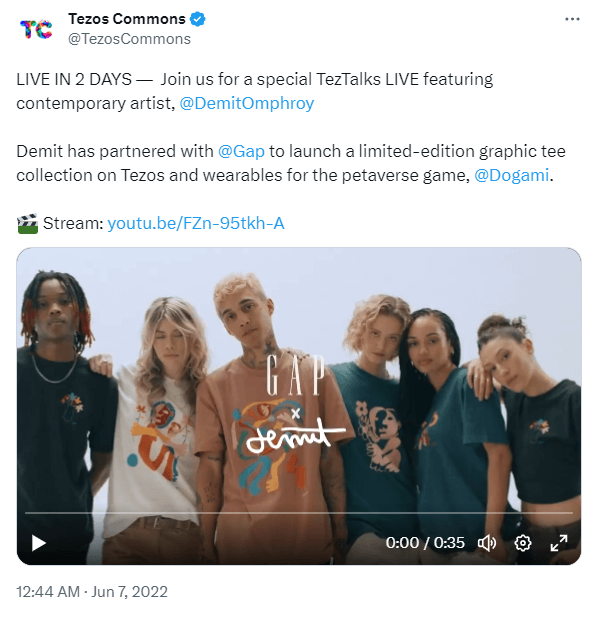
Gucci and Adidas dynamic duo
Adidas is no stranger to unlikely brand partnerships. Back in 2020, Adidas joined forces with sustainable shoe brand Allbirds, with a unified goal of designing running shoes that have minimal environmental impact. Then, in 2023, they teamed up with Gucci to create the Gucci-Addias footwear line.
This is a smart move for both brands, as they already have social clout and reputable brand reputations. The combination of Adidas’ athletic aesthetic with Gucci’s refined brand image has the potential to attract a broader audience. The implementation of this campaign, coupled with the resulting social media hype, is likely to enhance brand recognition, making it a strong marketing strategy.
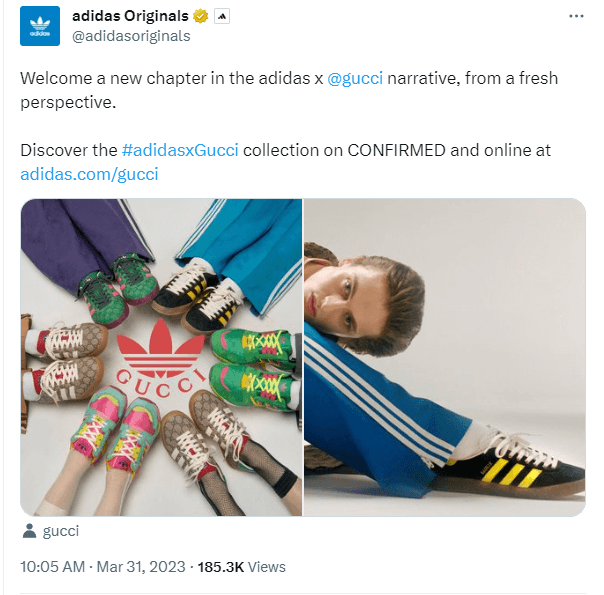
Zara’s next-level curb appeal
Sometimes simplicity gets the job done. Zara showed us that you don’t have to go over the top with curb appeal to steal the spotlight. They displayed a larger-than-average magenta and black QR Code on their storefront window. In the middle of that pixelated square were bold red letters, spelling out the words SALE. The message was clear: Snag the sale by scanning the square. Simple.
Employing retail QR Codes on the storefront window was pure genius for a couple of reasons. Zara’s customers could access information on sale items before entering the store, resulting in increased foot traffic both online and offline. Also, the retailer leveraged a pricing marketing strategy by drawing customers’ attention to their sales, potentially leading to higher conversion rates.
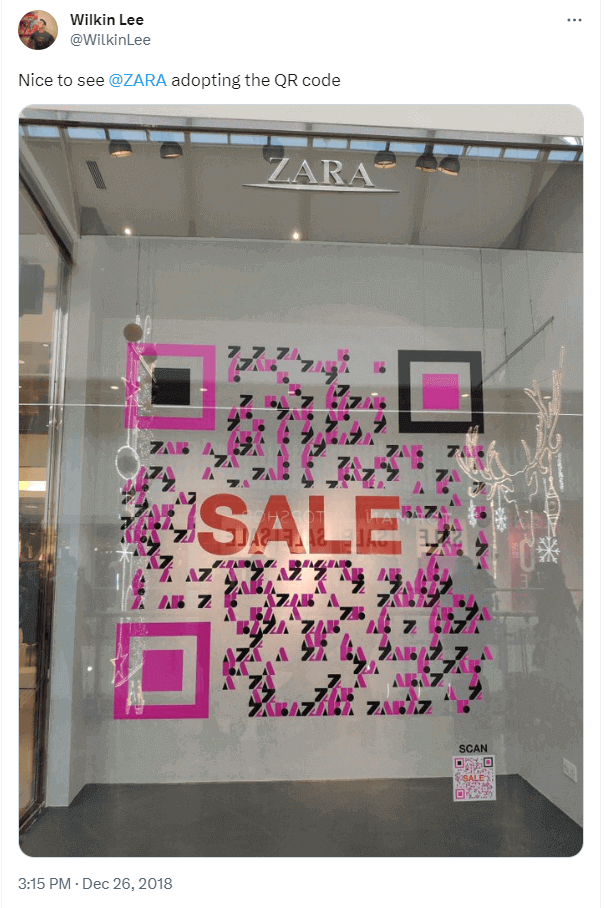
Changes on the horizon in retail
Big changes are happening in retail that will make a lasting impact. GS1, the organization behind developing and maintaining global standards for barcodes, is shifting from traditional barcodes to modern 2D barcodes like QR Codes. These new 2D barcodes have a GS1 Digital Link, allowing brands, retailers, and consumers to access online resources by simply scanning them—while still functioning as barcodes for purchases. GS1 is supporting retailers during this transition to GS1 barcodes, and by 2027, they are aiming for mainstream adoption.
Read our announcement about Bitly’s increased investment in powering connections by supporting the implementation of GS1 Standards in our products.
Take your retail marketing to the next level
Being in the retail industry comes with its set of unique challenges. But brands like those mentioned in this article are stellar models that the impossible can be done: You can achieve your marketing strategy goals while still meeting the demands of customers’ changing preferences.
The Bitly Connections Platform is your perfect retail marketing companion—create and manage short links, QR Codes, and Bitly Link-in-bios all in one place. Plus, get access to real-time tracking metrics so you always know what’s working, and what isn’t.
Give your business a boost and get started for free today.